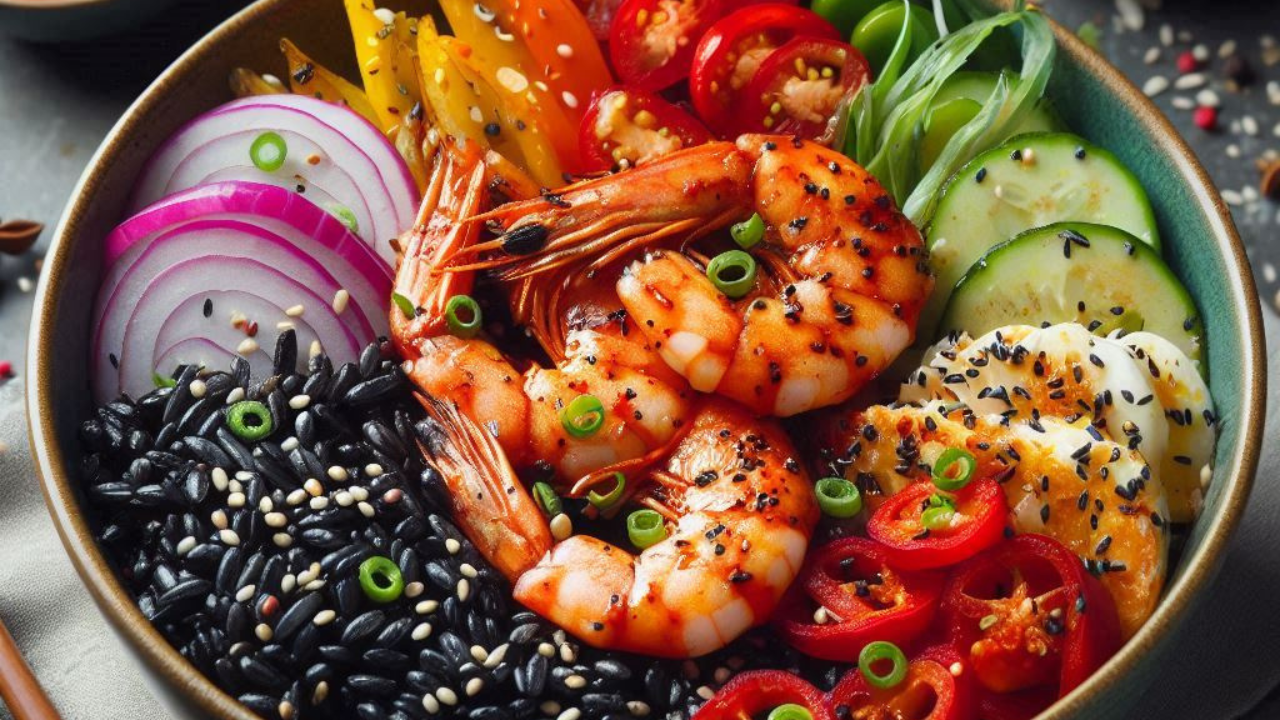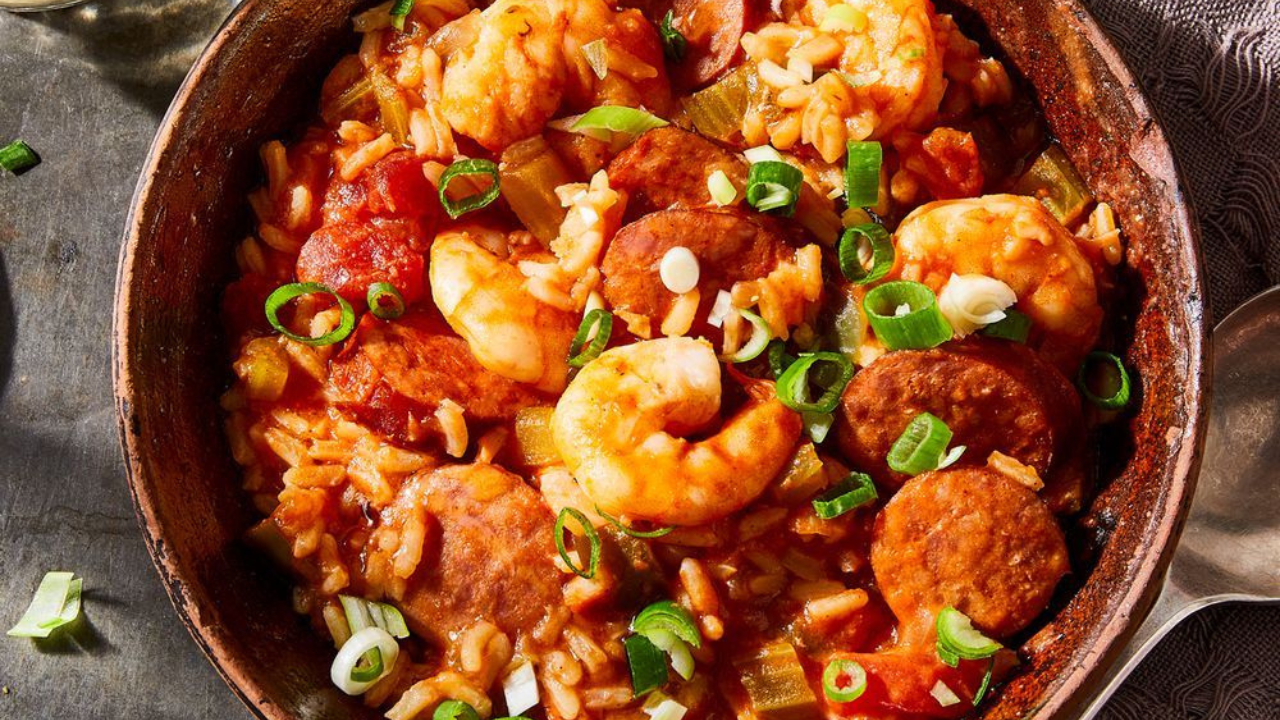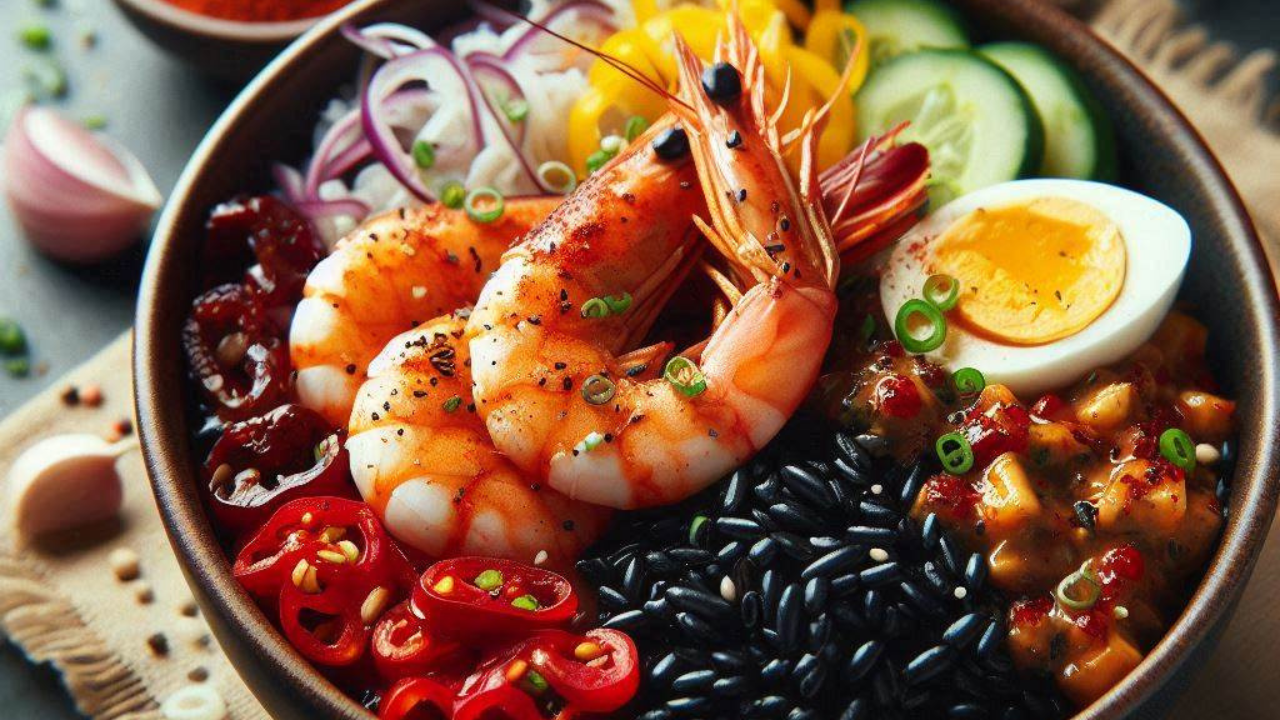Gochugaru Shrimp & Black Rice Bowls combine the fiery heat of Korean gochugaru chili flakes with succulent shrimp and the nutty, slightly chewy texture of black rice. This dish is a vibrant and nutritious meal that balances bold flavors with wholesome ingredients, creating a delightful culinary experience.
Ingredients and Nutritional Benefits
Shrimp:
- Shrimp is the star protein of this dish, known for its firm texture and slightly sweet flavor. It is rich in protein, low in fat, and a good source of essential nutrients like selenium, vitamin B12, and omega-3 fatty acids. Shrimp is also low in calories, making it an excellent choice for a healthy, satisfying meal.
Gochugaru:
- Gochugaru is a staple in Korean cuisine, consisting of dried Korean red chili flakes. It has a vibrant red color and offers a unique blend of spicy, smoky, and slightly sweet flavors. Gochugaru is packed with capsaicin, the compound responsible for its heat, which has been linked to various health benefits, including improved metabolism and reduced inflammation.
Black Rice:
- Black rice, also known as forbidden rice, is an ancient grain revered for its health benefits and striking appearance. It has a nutty flavor and a chewy texture, making it a nutritious base for the bowl. Black rice is high in antioxidants, particularly anthocyanins, which give it its dark color. It is also rich in fiber, vitamins, and minerals like iron, vitamin E, and magnesium.

Vegetables:
- A variety of colorful vegetables add freshness, crunch, and additional nutrients to the bowl. Common choices include bell peppers, cucumbers, carrots, and red cabbage. These vegetables are high in vitamins A and C, fiber, and antioxidants, contributing to overall health and well-being.
Sauce:
- The sauce for this dish typically combines elements like soy sauce, sesame oil, garlic, ginger, and a touch of honey or sugar to balance the heat from the gochugaru. This creates a flavorful and well-rounded dressing that enhances the taste of the shrimp and vegetables.
Garnishes:
- Common garnishes include sesame seeds, fresh herbs like cilantro or green onions, and a squeeze of lime juice. These additions not only add visual appeal but also contribute additional flavors and textures to the bowl.
Preparation Steps
1. Cooking the Black Rice:
- Rinse the rice: Rinse the black rice under cold water to remove excess starch. This step ensures that the rice cooks evenly and does not become too sticky.
- Cook the rice: In a medium saucepan, combine one part black rice with two parts water or broth. Bring to a boil, then reduce the heat to a simmer, cover, and cook for about 30-35 minutes, or until the rice is tender and the liquid is absorbed. Fluff the rice with a fork and set aside.
2. Preparing the Shrimp:
- Clean and devein the shrimp: If not pre-cleaned, peel and devein the shrimp, leaving the tails on if desired for presentation.
- Marinate the shrimp: In a bowl, combine gochugaru, soy sauce, minced garlic, grated ginger, sesame oil, and a touch of honey or sugar. Add the shrimp and toss to coat evenly. Let the shrimp marinate for at least 15 minutes to absorb the flavors.
3. Cooking the Shrimp:
- Heat a skillet: Heat a large skillet or wok over medium-high heat. Add a drizzle of oil.
- Cook the shrimp: Add the marinated shrimp to the hot skillet in a single layer. Cook for 2-3 minutes per side, or until the shrimp turn pink and opaque. Be careful not to overcook, as shrimp can become tough and rubbery.
4. Preparing the Vegetables:
- Chop the vegetables: While the rice is cooking and the shrimp is marinating, prepare the vegetables. Thinly slice or julienne bell peppers, cucumbers, carrots, and red cabbage. These vegetables will add a fresh, crisp element to the bowl.
5. Assembling the Bowl:
- Layer the components: Start with a generous scoop of black rice at the base of each bowl. Arrange the cooked shrimp on top, followed by the fresh vegetables.
- Drizzle with sauce: Drizzle the prepared sauce over the shrimp and vegetables, ensuring even distribution for maximum flavor.
6. Garnishing:
- Add garnishes: Sprinkle sesame seeds over the bowl for a nutty crunch. Add fresh herbs like cilantro or green onions for a burst of freshness. Finish with a squeeze of lime juice to enhance the flavors and add a tangy note.
Culinary Tips and Variations
Cooking the Rice:
- Using a rice cooker can simplify the process of cooking black rice. Follow the manufacturer’s instructions for the best results.
- For added flavor, cook the rice in vegetable or chicken broth instead of water.
Marinating the Shrimp:
- Allowing the shrimp to marinate for at least 30 minutes can intensify the flavors. For an even deeper flavor, marinate the shrimp overnight in the refrigerator.
Vegetable Variations:
- Feel free to customize the vegetables based on your preferences and what is in season. Options like snap peas, radishes, avocado, or edamame can add variety and additional nutrients.

Spice Level:
- Adjust the amount of gochugaru to control the spice level. For a milder dish, use less gochugaru or substitute with a milder chili powder.
Additional Protein:
- For extra protein, consider adding a soft-boiled egg, tofu, or edamame to the bowl.
Health Benefits
Rich in Antioxidants:
- The anthocyanins in black rice and the antioxidants in the vegetables help fight oxidative stress and inflammation, contributing to overall health and the prevention of chronic diseases.
High in Protein:
- Shrimp provides a lean source of protein that supports muscle growth, repair, and maintenance, making this dish ideal for those looking to increase their protein intake.
Fiber-Rich:
- The combination of black rice and fresh vegetables provides a significant amount of dietary fiber, promoting digestive health, and helping to maintain a healthy weight.
Low in Calories:
- Despite being packed with flavor, this dish is relatively low in calories, making it suitable for those aiming to manage their calorie intake without sacrificing taste.
Balanced Nutrition:
- This bowl offers a balanced mix of macronutrients (protein, carbs, and fats) and micronutrients (vitamins and minerals), supporting overall health and well-being.
Boosts Metabolism:

- The capsaicin in gochugaru can help boost metabolism and promote fat burning, aiding in weight management efforts.
Serving Suggestions
Gochugaru Shrimp & Black Rice Bowls can be served as a standalone meal, providing a complete balance of nutrients. However, they also pair well with:
Kimchi:
- A side of kimchi adds an extra layer of flavor and probiotics, which are beneficial for gut health.
Miso Soup:
- A warm bowl of miso soup complements the fresh and spicy flavors of the shrimp bowl and provides additional nutrients.
Green Tea:
- A cup of green tea is a refreshing beverage that also offers antioxidant benefits and aids digestion.
FAQs:
1. What is gochugaru?
Answer: Gochugaru is a type of Korean chili powder made from sun-dried red chili peppers. It has a vibrant red color and offers a unique combination of spicy, smoky, and slightly sweet flavors. It is commonly used in Korean cuisine for dishes like kimchi and various stews.
2. How spicy are gochugaru shrimp bowls?
Answer: The spice level of gochugaru shrimp bowls can vary depending on the amount of gochugaru used. Gochugaru has a moderate heat level, but you can adjust the quantity to suit your taste preferences. For a milder version, use less gochugaru or substitute with a milder chili powder.

3. What are the health benefits of black rice?
Answer: Black rice, also known as forbidden rice, is rich in antioxidants, particularly anthocyanins, which give it its dark color. It is high in fiber, vitamins, and minerals such as iron, vitamin E, and magnesium. Black rice supports heart health, aids in digestion, and helps maintain a healthy weight.
4. Can I use a different type of rice?
Answer: Yes, you can substitute black rice with other types of rice such as brown rice, jasmine rice, or basmati rice. However, black rice offers unique nutritional benefits and a distinctive nutty flavor and chewy texture that complement the dish.
5. What type of shrimp is best for this recipe?
Answer: Fresh or frozen medium to large shrimp, preferably peeled and deveined, work well for this recipe. Wild-caught shrimp are often recommended for their better flavor and sustainability. You can leave the tails on for presentation or remove them for easier eating.
6. How do I store leftovers?
Answer: Store leftover gochugaru shrimp and black rice bowls in an airtight container in the refrigerator for up to 3 days. Reheat the shrimp and rice separately in the microwave or on the stovetop to maintain the best texture and flavor.
7. Can I make this dish ahead of time?
Answer: Yes, you can prepare components of the dish ahead of time. Cook the black rice and chop the vegetables in advance. Marinate the shrimp and store everything separately in the refrigerator. When ready to serve, cook the shrimp and assemble the bowls.
8. Are there vegetarian or vegan alternatives?
Answer: Yes, you can substitute the shrimp with tofu, tempeh, or a plant-based protein alternative. Marinate and cook the tofu or tempeh in the same way as the shrimp to infuse it with the gochugaru flavor.
9. What vegetables work best in this bowl?

Answer: Fresh, crunchy vegetables like bell peppers, cucumbers, carrots, and red cabbage are excellent choices. You can also add snap peas, radishes, avocado, or edamame for variety. Feel free to customize based on your preferences and seasonal availability.
10. What sauce is used for this dish?
Answer: The sauce for gochugaru shrimp bowls typically includes soy sauce, sesame oil, minced garlic, grated ginger, and a touch of honey or sugar. This combination creates a flavorful and balanced dressing that complements the shrimp and vegetables.
11. Can I use store-bought sauce?
Answer: Yes, you can use store-bought sauces like teriyaki, soy-ginger, or a spicy Korean sauce if you’re short on time. However, making the sauce from scratch allows you to control the ingredients and adjust the flavors to your liking.
12. How can I add more protein to this dish?
Answer: You can add additional protein sources like a soft-boiled egg, tofu, tempeh, or edamame. These options will enhance the nutritional value and make the dish even more satisfying.
13. What garnishes work well with gochugaru shrimp bowls?
Answer: Common garnishes include sesame seeds, fresh herbs like cilantro or green onions, and a squeeze of lime juice. These garnishes add visual appeal, flavor, and texture to the dish.
14. Is this dish suitable for gluten-free diets?
Answer: Yes, this dish can be made gluten-free by using gluten-free soy sauce or tamari and ensuring that all other ingredients are gluten-free. Always check labels to confirm the absence of gluten.
15. How do I cook black rice perfectly?
Answer: To cook black rice, rinse it under cold water to remove excess starch. Combine one part black rice with two parts water or broth in a saucepan. Bring to a boil, then reduce heat to a simmer, cover, and cook for 30-35 minutes or until tender. Fluff with a fork before serving.
16. Can I freeze this dish?

Answer: While the components of the dish can be frozen separately, the texture of the shrimp and vegetables may change after freezing and reheating. It’s best to freeze the cooked black rice and prepare the shrimp and vegetables fresh for optimal texture and flavor.
17. What are some side dishes that pair well with gochugaru shrimp bowls?
Answer: Complementary side dishes include kimchi, miso soup, or a simple green salad. These sides add variety and balance to the meal, enhancing the overall dining experience.
18. Are there any other spices I can use instead of gochugaru?
Answer: If you don’t have gochugaru, you can use crushed red pepper flakes or a combination of paprika and cayenne pepper to mimic the heat and color. However, the unique flavor of gochugaru is hard to replicate exactly.
19. What beverages pair well with this dish?
Answer: Refreshing beverages like green tea, iced tea, or a light lager beer pair well with the spicy and savory flavors of gochugaru shrimp bowls. These drinks help cleanse the palate and enhance the dining experience.
20. Can I serve this dish cold?
Answer: Yes, gochugaru shrimp bowls can be enjoyed cold, making them a great option for meal prep or picnics. Ensure the shrimp and rice are fully cooled before assembling the bowl and storing it in the refrigerator until ready to serve.
Conclusion:
Gochugaru Shrimp & Black Rice Bowls are a delicious and nutritious meal option that brings together the best of Korean flavors and wholesome ingredients. The combination of tender shrimp, spicy gochugaru, nutty black rice, and fresh vegetables creates a harmonious dish that is both satisfying and healthful. This recipe is versatile and can be customized to suit individual tastes and dietary preferences, making it a great addition to any meal plan. Enjoy the vibrant flavors and numerous health benefits of this delightful dish!

